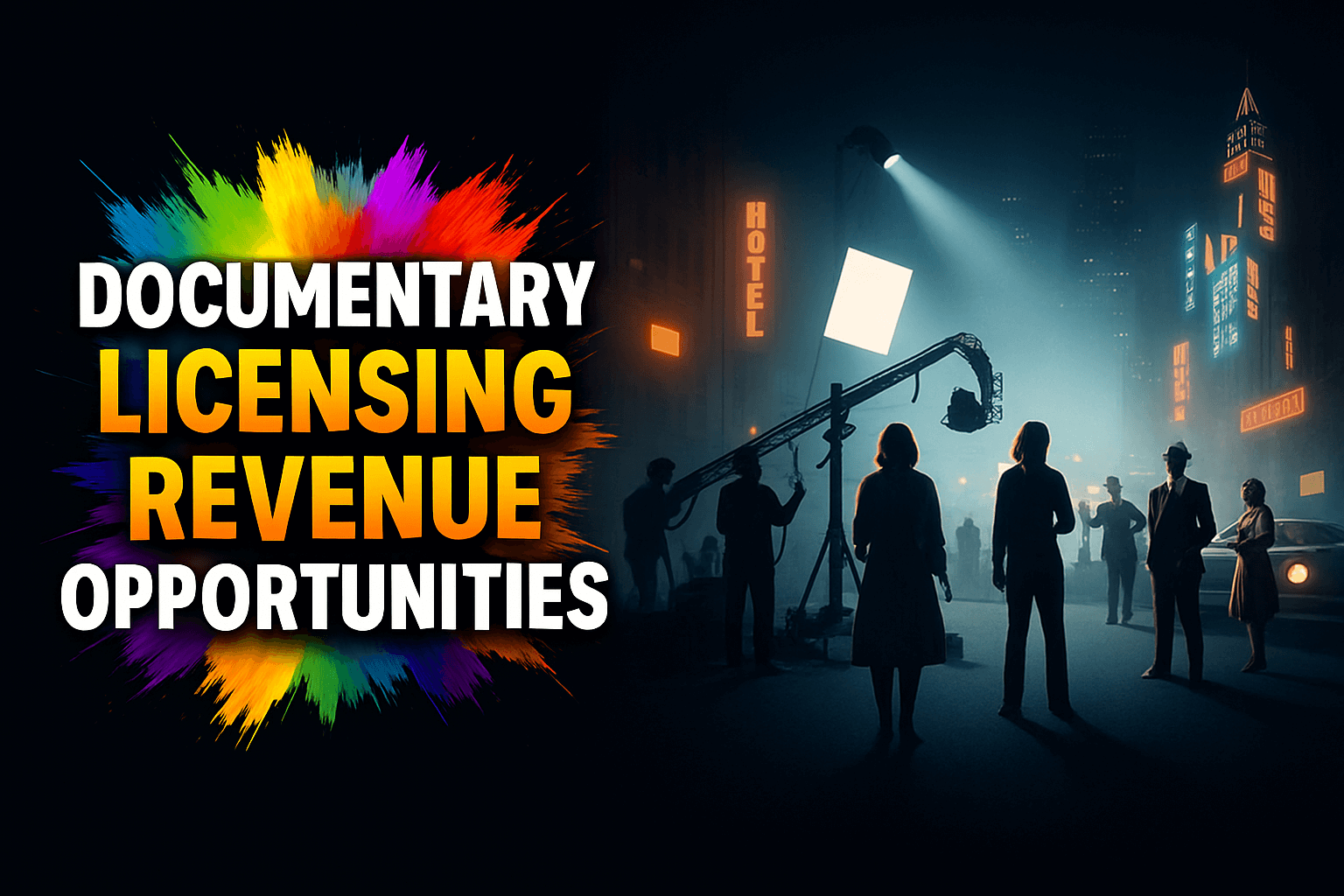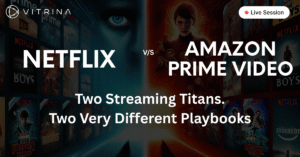Maximizing Documentary Licensing Revenue Opportunities: Strategic Alerts for Producers

Introduction
The global market for documentary, licensing, revenue opportunities, alerts has expanded far beyond the traditional model of grants and public television sales. Driven by the voracious content appetites of streaming platforms, non-fiction content is now a high-stakes, high-return asset category.
For executive producers and financiers, the challenge is not whether the audience exists (the market is valued in the billions, growing at a CAGR of over 5.5% through 2034, according to Global Growth Insights, but how to navigate the complex web of global rights, platform strategies, and competitive intelligence to maximize its licensing revenue opportunities.
This guide provides the strategic framework for adopting an intelligence-first approach to documentary monetization.
Table of content
- The Documentarian’s New Reality: Why Licensing Revenue Opportunities are Critical
- Maximizing Documentary Licensing Revenue Opportunities Across Platforms
- The Need for Competitive Intelligence and Market Alerts
- Operationalizing Your Business Development Pipeline
- How Vitrina Delivers Actionable Alerts and Intelligence for Documentary Producers
- Conclusion: Precision Intelligence as the Path to Documentary Success
- Frequently Asked Questions
Key Takeaways
| Core Challenge | Fragmented global distribution, complex Intellectual Property (IP) Clearance, and a lack of real-time visibility into which platforms are actively commissioning or buying specific documentary content. |
| Strategic Solution | Adopting a data-driven approach using alerts and real-time project tracking to identify specific buyer needs and secure early pre-sale and licensing deals. |
| Vitrina’s Role | Vitrina provides the verified executive contacts, company profiles, and alerts on documentary projects in development/production to enable precise, timely deal-making. |
The Documentarian’s New Reality: Why Licensing Revenue Opportunities are Critical
The financial model for documentary films has fundamentally shifted from a reliance on soft money (grants, foundations) to the aggressive competition of the commercial media marketplace.
This is a direct consequence of global streaming platforms recognizing that non-fiction content is a vital, cost-effective tool for attracting and retaining subscribers.
This shift elevates licensing revenue opportunities from a secondary concern to a primary strategic goal for every production.
The structural evolution is profound: The global market for documentary content is projected to rise to nearly $9 billion by 2033, demonstrating the robust revenue opportunities available Straits Research.
This growth is fueled by an increasing audience preference for authentic narratives that address social, environmental, and personal issues. However, maximizing these opportunities is complex.
The first hurdle is The Structural Challenge of IP Clearance and Rights Management. Documentary films, by their very nature, rely heavily on archival footage, music, on-screen personalities, and complex location permissions. Clearing all necessary Intellectual Property (IP) Clearance rights—and having the verified documentation to prove it—is a non-negotiable prerequisite for securing a high-value global licensing deal.
Failure to properly clear rights introduces legal risk, which distributors and major platforms will not absorb, severely limiting the project’s revenue opportunities and distribution reach. This is often the point where many promising projects stall.
Maximizing Documentary Licensing Revenue Opportunities Across Platforms
The path to maximizing documentary, licensing, revenue opportunities requires a multi-faceted approach that strategically sequences different distribution windows and financing sources.
The days of a single, simple distribution deal are gone, replaced by The Multi-Window Strategy: Theatrical, Broadcast, and OTT Licensing.
This involves carefully staging the release: a prestige theatrical run to generate buzz and awards eligibility, followed by a broadcast sale (e.g., to a public broadcaster for cultural legitimacy), and finally, a lucrative global or multi-territory OTT (streaming) license.
Each window is a separate licensing revenue opportunity, and timing is critical to avoid rights conflicts. To pull this off, producers are increasingly turning to Hybrid Financing and the Pre-Sale Revenue Opportunity.
Given the high production and research costs often associated with documentary filmmaking, relying solely on post-production sales is high-risk. Savvy producers secure financing through a hybrid model that involves pre-selling territorial or window-specific rights (pre-licensing) to specific buyers (e.g., a German broadcaster buys the European rights pre-production) while simultaneously seeking grants or equity.
This demonstrates market viability and helps cover the upfront costs, providing the production with an essential financial alert and stability.
The Need for Competitive Intelligence and Market Alerts
In the modern, saturated content market, a great documentary concept is not enough; it must be timely, unique, and strategically aligned with a buyer’s content slate.
This makes competitive intelligence and alerts essential for securing documentary licensing revenue opportunities. Tracking Content Acquisition Strategies of Key Buyers is non-negotiable.
Executive producers must use data to understand what a specific streaming platform or network is not currently producing. For example, a platform that has five true-crime docuseries in development might pass on another, whereas one with a gap in environmental or biographical docs will be a priority target.
Intelligence on a buyer’s current content slate, active partners, and preferred genres is what transforms a cold pitch into a highly targeted business proposal.
This requires an Early Warning: Project Tracking as a Pre-Sale Catalyst. Alerts on new competitive projects entering development globally are vital. If a competing project with a similar theme or subject is announced, a producer must know immediately to pivot their pitch, accelerate financing, or target a different buyer before the window of opportunity closes.
Real-time project tracking enables the producer to act as a market insider, turning intelligence into a financial advantage by securing the necessary funding or distribution before the competition does.
Operationalizing Your Business Development Pipeline
The shift to an intelligence-first approach requires operational efficiency in the business development pipeline. Manual vetting and contact sourcing are liabilities in a market that moves at the speed of content.
Automating Buyer Due Diligence and Vetting is the core operational upgrade. Before pitching, the producer needs an instant, comprehensive profile of the potential licensee, including their corporate ownership structure, regional mandates, and track record of previous licensing deals.
This due diligence must be automated, allowing the producer to vet dozens of potential partners quickly and filter out those with conflicting rights or unsuitable strategies. This efficiency is paramount for maximizing revenue opportunities in a global market. Once the buyer is vetted, the next challenge is Finding Verified Executive Contacts for Niche Content.
The responsible acquisition executive for a niche documentary in a specific territory (e.g., APAC head of factual content) is notoriously difficult to find. Producers need a system that provides executive/person search with verified, department-tagged contacts.
This allows the creative team to bypass the generic acquisition inbox and pitch directly to the decision-maker who holds the budget and the mandate for their specific non-fiction content. For more on efficient partner discovery, explore this guide on Distribution and Licensing Solutions.
How Vitrina Delivers Actionable Alerts and Intelligence for Documentary Producers
Vitrina is the global leader in tracking the M&E supply chain, built specifically to solve the data scarcity and fragmentation that undermine documentary licensing revenue opportunities.
We empower producers with precision intelligence and essential alerts. Our platform achieves this by Pinpointing the Right Partner with Verified Company Profiles.
Vitrina tracks over 300,000 companies, providing verified data on studios, streamers, distributors, and financiers, including their ownership structure and deal track record.
Our executive/person search functionality houses millions of CXOs and department heads, tagged by specialization, ensuring that the producer can find the exact individual responsible for purchasing their type of content. Crucially, Vitrina enables Leveraging Real-Time Project Tracking for Timely Pitches.
The Vitrina Project Tracker provides real-time alerts on new film and TV projects entering development and production globally. For a documentary producer, this is the ultimate competitive advantage, providing an Early Warning System to identify strategic gaps in a buyer’s slate or a competing project that requires a rapid change in strategy.
This system allows the producer to move from reactive pitching to proactive, data-backed deal-making, maximizing their licensing revenue opportunities.
Conclusion: Precision Intelligence as the Path to Documentary Success
The global demand for documentary, licensing, revenue opportunities, alerts is robust and growing, but the market is unforgiving of inefficiency. The producer who relies on anecdotal evidence or manual outreach will be left behind.
The future of documentary monetization belongs to the executive who masters the strategic use of competitive intelligence.
By employing real-time project tracking and a data-backed approach to identify buyer needs, secure pre-sales, and ensure meticulous IP management, producers can transform a complex creative endeavor into a high-return commercial asset.
Precision intelligence is the key to unlocking maximum licensing revenue opportunities for non-fiction content globally.
Frequently Asked Questions
Documentary licensing revenue opportunities vary widely based on production cost, subject matter, and the distribution deal. While many independent films rely on grants, high-end documentaries sold to major global streaming platforms can command six-to-seven-figure license fees, often supplemented by territory-specific broadcast and educational sales.
The key challenges center on Intellectual Property (IP) Clearance, specifically securing all rights for archival footage, third-party music, and location releases across all territories and distribution windows (theatrical, broadcast, streaming). Failure to do so risks lawsuits and prevents a project from securing major global licensing deals.
Film festivals serve as crucial market entry points. A premiere at an A-list festival generates the necessary buzz and endorsement to attract distributors and content buyers. This endorsement significantly increases the perceived market value of the film, accelerating the process of negotiating and securing licensing revenue opportunities.
Alerts for new projects (competitive intelligence) allow a producer to identify a market gap (i.e., no similar projects in development), which strengthens the pitch for financing. Conversely, they serve as a critical alert if a direct competitor is announced, enabling the producer to pivot their subject, marketing, or target buyer to protect their documentary licensing revenue opportunities.















































